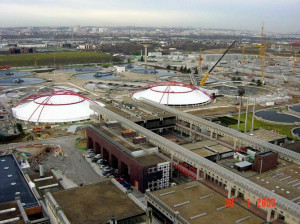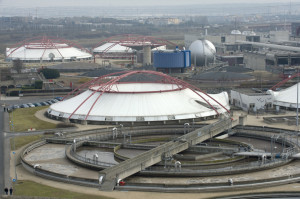During works undertaken to modernise a Seveso joint municipal treatment plant, an employee returned a mobile crane to the plant parking lot after moving a pump. At 10:30 am, the arm on the device, placed in its upper position, struck the portal frame supporting an above-ground biogas pipe running 5.9-m above the roadway. Due to the shock effect, the frame was ripped from its concrete blocks and collapsed. The pipe twisted and, over several metres, separated from its supports installed along the roadway; however, it remained intact. The employee exited his cab and at 10:32 pressed the emergency shutoff switch, which subsequently tripped the pipe’s cut-off valve and turned off the biogas compressors connected to a storage tank via the damaged pipe. This sudden shutdown caused a slight ever pressure surge in the expansion space of the anaerobic digesters, thus generating biogas and opening the digesters’ safety valves. Personnel operating the “sludge” unit pipeline then started flaring the biogas output by these digesters, but 250 m³ of biogas (i.e. 0.2 t, composed of 60 % flammable methane) were released into the atmosphere through the safety valves for a period long enough to trigger flaring given that the high level had been reached in the flexible gas-holder where all of the biogas produced was directed. The internal emergency plan was activated at 10:35 and staff evacuated the plant premises. Inerting of the damaged pipe was initiated at 10:50; next, the biogas pipes upstream of the compressors and downstream of the storage tank were locked out by means of padlocked valves and top plates. While awaiting repairs, plant operations continued, although the biogas released was directly burned at the flare without any reuse opportunity. Damages were estimated at €150,000.
The mobile crane driver had raised the arm, since in the lower position, it hindered visibility on the right side and in the rear-view mirror, placing the arm instead in the highest position to avoid having the muffle in reach of plant personnel (risking injury due to sway). Moreover, the vehicle height indicator only displayed muffle height and not total arm height, thus leading drivers to ignore this particular parameter.
The operator implemented the following corrective measures:
- installation of portal frames to protect all above-ground pipe crossings and footbridges ;
- a designated vehicle to systematically escort the mobile crane during movements with the arm lowered, in order to compensate for its lack of visibility ;
- a study to replace the mobile crane by a model featuring improved visibility with the arm lowered ;
- enhanced driver awareness of the type of height indications shown by the device.





